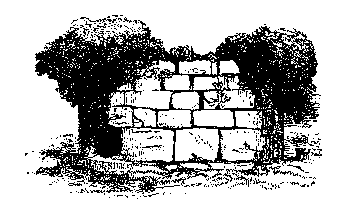Chapter 4: Eanach Dúin (Annaghdown) to Coill Beag
- Parish of Annaghdown
- Disaster of Annaghdown
- Monastery and Abbey
- Nunnery
- Bellhouse
- Annaghdown Castle
- Craobh Castle
- Kilcoona Round Tower
- St. Cuana
- Cloch-an-Uabhair Castle
- Lee's Island
- Cnoc Ferry and Coill Beag
Return to table of contents
Refer to Map
A deep bay borders the north-west margin of Annaghdown parish, as far as the mills of Coill Rua, where the parish of Cill Chuana abuts upon Loch Coirib. Passing eastward and crossing the main road from Galway to Headford, by Ballinduff, and near Cathair Mor, through a country studded with raths and cahers, we reach the little church and burial ground of St. Cuana, nearly in the centre of the enclosure of which stands the butt of the Round Tower, which I am inclined to believe is that referred to by the annalists as having been erected in 1238, (see illustration). It stands upon a double plinth, and is now eight feet high and fifty-two feet nine inches in girth. The stones, some of which upon the lower course are five feet two inches long, of a yellowish white limestone, are dressed, cambered on the outside, and laid in regular courses; and in some instances, as may be seen in the engraving, cut into each other, after the manner of the ancient Cyclopean masonry. No vestige of the doorway remains, as the present top is below the level of the usual site of that portion of a Cloictheach or Irish round tower, but it was probably on the east face. The interior of the tower is at present a solid mass of clay and stones, from which some luxuriant ivy has thrown its projecting arms around the ruin, and at the same time added to its picturesque effect.

The long, narrow parish of Cill Chuana, running nearly north and south between those of Eanach Dúin and Cill Éanna, occupies about two miles of lake shore, and is crossed by the high road between Gaillimh and Ath Chinn.
A few paces to the northeast are the ruined walls of a church, sixty-six feet five inches long, and twenty-four feet wide outside, with the gables still standing; but there are no carved stones throughout the building that afford us any means of conjecturing its date. Archdall says: "Tipraid, Prince of Hyfiachra, granted the abbey of Killchunna to St. Columb, who placed St. Cuanna over it; he was maternal brother to St. Carthag, and was afterwards removed to the abbey of Lismore. This is now [1786] a parish church."